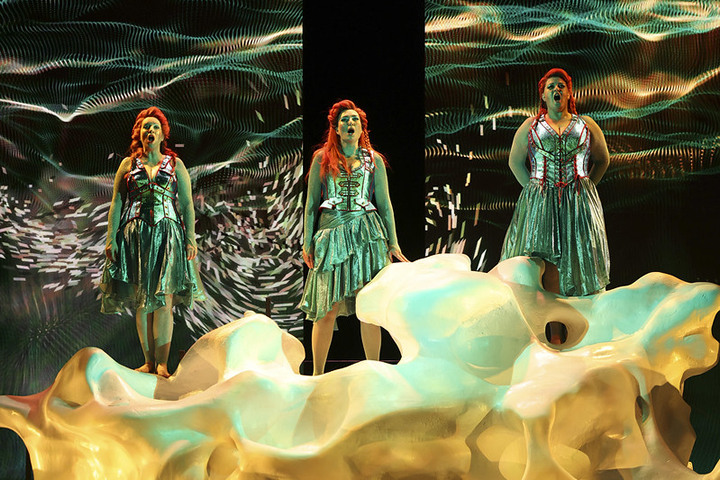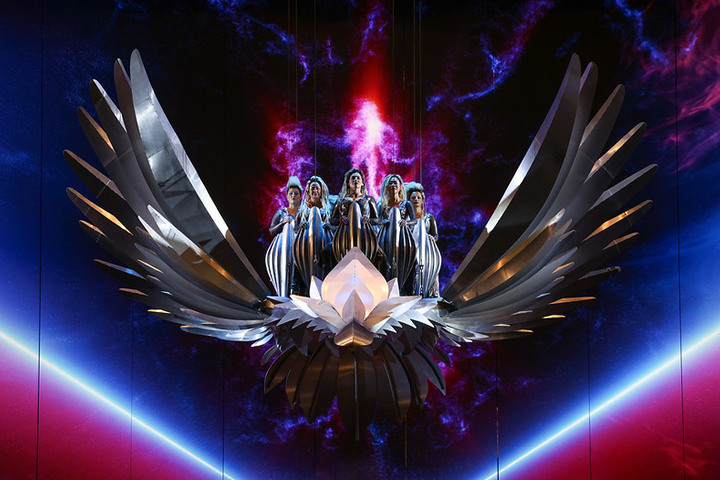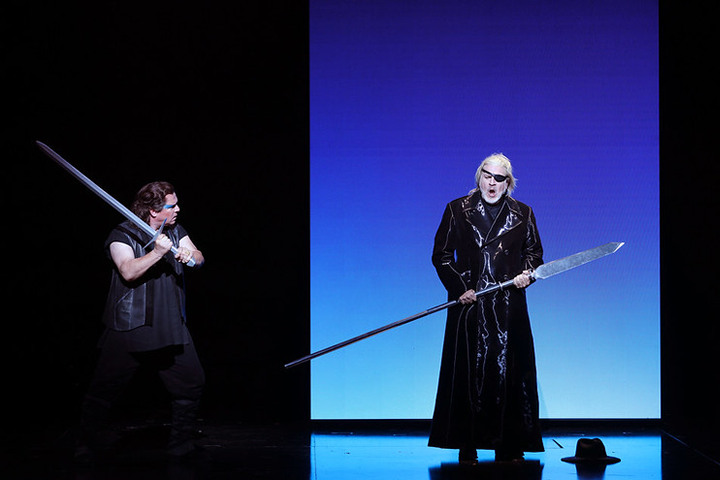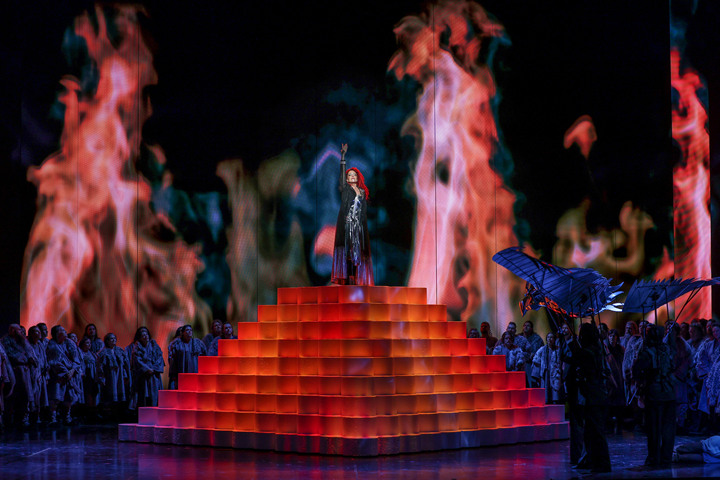| Opera Reviews | 28 April 2024 |
Opera Australia's digital Ring is a resounding successby Michael Sinclair |
|
Wagner: Der Ring des Nibelungen |
|

Das Rheingold - Lorina Gore (Woglinde), Jane Ede (Wellgunde), Dominica Matthews (Flosshilde)
|
|
|
In the long build up to these Ring performances, first conceived in 2017 and twice cancelled due to Covid, most of the emphasis had been placed on the digital effects that would be used to bring Wagner’s tetralogy to life. Teaser videos had given a brief insight as to what we were to expect and certainly whetted the appetite for more. Director, Chen Shi-Zheng and his Digital Content Designer Leigh Sachwitz, in conjunction with flora&faunavisions, had the enormous task of designing the content for hundreds of LED panels over the course of fifteen hours of music, while not drowning us in a sea of sensory overload. As Chen said in an interview with Bachtrack, “Digital is not easy! … I realised nobody wanted to be facing this huge bright thing for four hours – you’d need to give the audience sunglasses.” Set primarily in a parallel multiverse the production eschews universality as one of its main themes with Chen keen to create a ‘new world myth’ where ancient mythology embraces modern science fiction to create a vision that is relevant to all. The ever changing digital stage pictures were both immense and intimate, both abstract and specific, allowing time, space, and emotions to be explored in the many layers found in the Ring. The big scenes were as spectacular as you could hope for – the Ride of Valkyries; the end of Die Walküre with its wonderful fire effect; the dark and brooding forest scene in Siegfried with its digital dragon and acrobatic woodbird; and the immolation scene at the end of Götterdämmerung, to name but a few. But equally some of the best stage pictures were created during the transitions between scenes when it was quite a marvel to watch the LED panels rise and fall, rotate and move around the stage creating new vistas as the scenes changed. There were inevitably a few miscalculations, and these were generally when the digital content became too intrusive, or was perhaps a bit gaudy, and diminished what was happening on stage or the music itself. One example of this was during Wotan’s monologue in Act II of Die Walküre where the focus needed to be on the singers, rather than having the feeling that Wotan and Brünnhilde were having a conversation while exploring an art installation. But these miscalculations were few and far between, and overall the visual side of this production was spectacularly original and a resounding success. |
|

Die Walküre - Dominica Matthews (Schwertleite), Deborah Humble (Waltraute), Jennifer Black (Ortlinde), Mariana Hong (Helmwige), Agnes Sarkis (Siegrune)
|
|
|
Given the director’s heritage it is not surprising that Eastern influences pervaded the production. We first see Wotan and Fricka sitting in Buddhist poses in an elegant abode with Chinese dogs adorning the room; the ash tree in Act I of Die Walküre was a scaled-up replica of a bonsai tree from Suzhou; bunraku style puppetry was used to create Grane, Brünnhilde’s horse, which here is a mythological Chinese bird; while a large Chinese style serpent dragon was magically used to create the ring of fire to protect Brünnhilde at the end of Die Walküre. The use of these influences has been carefully managed and there was certainly no feeling that this quintessentially Western opera had been hijacked by Eastern culture. Perhaps the most controversial aspect of this Ring was the decision to use dancers (Opera Australia Dancers and Dancenorth Australia) throughout the four operas. Who knew that the Ring has a ballet? While the use of dance at the end of Das Rheingold seemed like a miscalculation as it distracted from the majestic music that ends the opera, it was totally in sync with the action during the Ride of the Valkyries in Die Walküre as the dancers provided the necessary movement and energy that are inherent in the music, while the Valkyries themselves were placed statically in their phoenix-like chariot, itself a coup de théâtre. Chinese ribbon dancers accompanied the forging segment in Siegfried, while in Götterdämmerung their only contribution was to accompany Siegfried on his funeral march. Within this framework Chen directed his singers in a straightforward way with clear storytelling that stuck largely to the libretto. If his directorial hand was a little light in the first two operas this changed as the drama intensified and by Götterdämmerung he was totally in control of the dramatic elements of the plot. The stage pictures were completed by Anita Yavich’s beautifully crafted costumes which were perfectly in tune with the many characters in the opera: the Gods were elegant in their long white trench coats; the Valkyries shimmered in their silvery dresses; and the Gibichungs were imposing in their fur adorned outfits. |
|

Siegfried - Stefan Vinke (Siegfried), Daniel Sumegi (Der Wanderer)
|
|
|
While there was much to enjoy visually, the musical side of this production by no means played second fiddle. Opera Australia assembled a cast of both local and overseas singers and there wasn’t a weak link in the entire ensemble with many singers singing their roles for the first time. The stars of the show were undoubtedly Lise Lindstrom and Stefan Vinke as Brünnhilde and Siegfried respectively. They are both seasoned performers in their roles having performed them regularly around the world, including in Opera Australia’s 2016 Ring cycles, and their experience shone through. Lindstrom looked and sounded well-nigh ideal as the warrior maiden bringing a range of emotions to her character - love, bewilderment, anger, and ultimately self-sacrifice. She completely commanded the stage in Götterdämmerung bringing the opera to its fateful conclusion with a thrilling yet tender account of the immolation scene which brought tears to the eyes. Vinke’s Siegfried was a phenomenon. While he may not have offered the most nuanced of performances, his stamina and vocal credentials combined to create an ebullient and likeable character. The most notable debut was given by Daniel Sumegi as Wotan (Das Rheingold and Die Walküre) and Der Wanderer (Siegfried). His virile baritone was ideal for the younger Wotan in Das Rheingold, yet he transitioned with ease to the more troubled character in Die Walküre with a wonderfully nuanced performance. In Siegfried the gravitas he brought to the world-weary Wanderer ably demonstrated his ability to portray the character’s complexities across the three evenings in which he performed. Warwick Fyfe’s Alberich is again familiar from Opera Australia’s previous Ring. His dark, well-projected, blood curdling voice was ideal for this evil, slimy character, allowing him to make the most of the opportunities the role offers. Rosario La Spina and Anna-Louise Cole sang Siegmund and Sieglinde with ardent intensity and passion in Die Walküre bringing Act I to a rousing close with both voices soaring effortlessly above the orchestra. Cole steps up to the role of Brünnhilde in the third cycle, no doubt an indication of where her career is heading. |
|

Götterdämmerung - Lise Lindstrom (Brünnhilde)
|
|
|
Andrea Silvestrelli was the only singer to perform in all four operas. His Fafner in Das Rheingold was followed by a thuggish Hunding in Die Walküre where his dark, menacing voice was used to chilling effect. He returned to Fafner in Siegfried, then finally Hagen in Götterdämmerung where he created an oily character that oozed nastiness and evil. Hubert Francis was an audience favourite as Loge in Das Rheingold, his flexible tenor voice well able to project and portray Loge’s sinewy character as he acted as Wotan’s fixer. In Die Walküre Deborah Humble was a knockout as Fricka. The admonishment of her husband was an exercise in operatic acting at its best, and this combined with her strong mezzo voice resulted in a performance that was all class. She brought a similar level of intensity to her Waltraute in Götterdämmerung. Luke Gabbedy was an unusually strong and powerful Gunther trying hard to stand up to his half-brother Hagen, while Maija Kovalevska was a wide-eyed innocent Gutrune, though both ultimately succumbed to Hagen’s treachery. All the other roles were strongly sung and characterised and the contribution of the Opera Australia Chorus, directed by Paul Fitzsimon, was outstanding in Götterdämmerung. Philippe Auguin is an experienced Ring conductor and it shows. He clearly understands the work as a whole and the dynamics within the score, being able to draw hushed pianissimos from the orchestra that carried as much weight and meaning as the big fortissimo moments. If Das Rheingold seemed a little undernourished, Die Walküre was suitably lyrical and passionate with the necessary dynamic range that had been missing in the earlier opera. Auguin concluded the cycle with performances of Siegfried and Götterdämmerung that were strong on dramatic intensity, yet remaining sensitive to his singers as the orchestral textures became increasingly richer. The Ring Cycle Orchestra, drawing on players from the Queensland Symphony Orchestra and from around Australia and the world, responded beautifully to Auguin’s interpretation playing their hearts out over the course of the four evenings. Overall the cumulative effect of this Ring was overwhelming. A somewhat muted, yet elegant Das Rheingold gave way to a lyrical Die Walküre where the love music for Siegmund and Sieglinde and Wotan’s farewell to Brünnhilde were both heartachingly beautiful and meltingly poignant. By Siegfried as the screw turns and fate takes its inevitable course, the intensity of this production moved up a few notches. By now the visual elements were combining powerfully with the music to create a dramatic whole, giving us the Gesamtkunstwerk that Wagner strove for. Götterdämmerung was a triumph from beginning to end with its spellbinding storyline and larger than life characters, culminating in Lindstrom’s exquisitely sung immolation scene that combined thrilling vocals with a heart wrenching farewell to both Siegfried and the world. The final flashback of images we had seen throughout the production took us back to the beginning in a most moving way. A fitting end to a magnificent production. |
|
| Text ©
Michel Sinclair Photos © Wallis Media |
|







